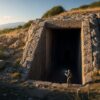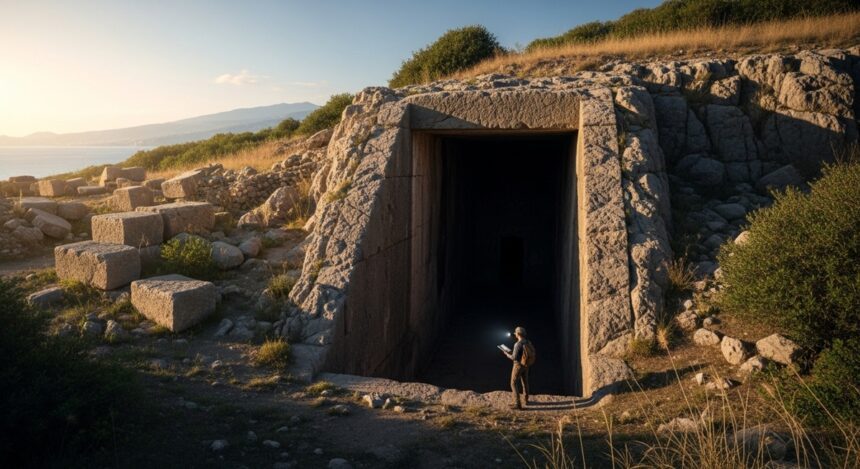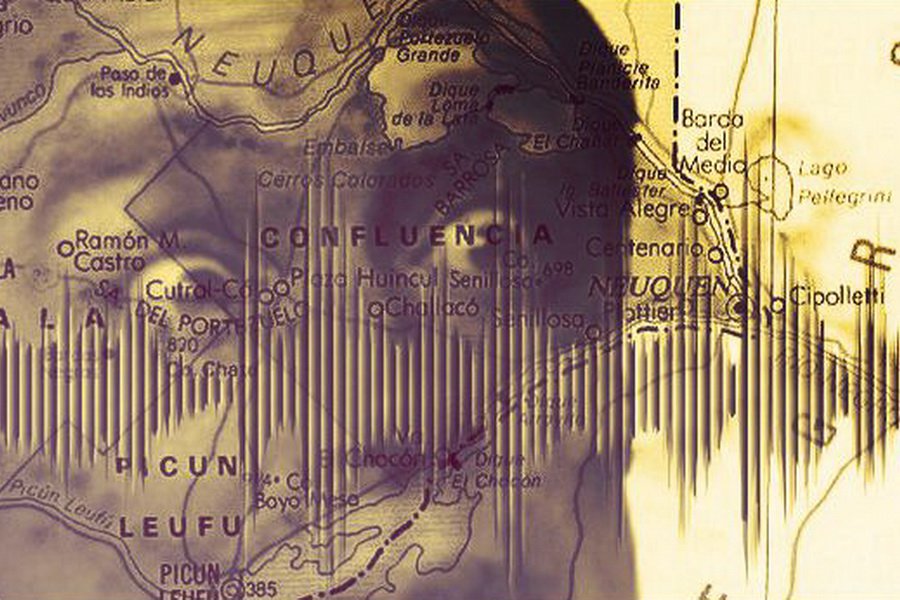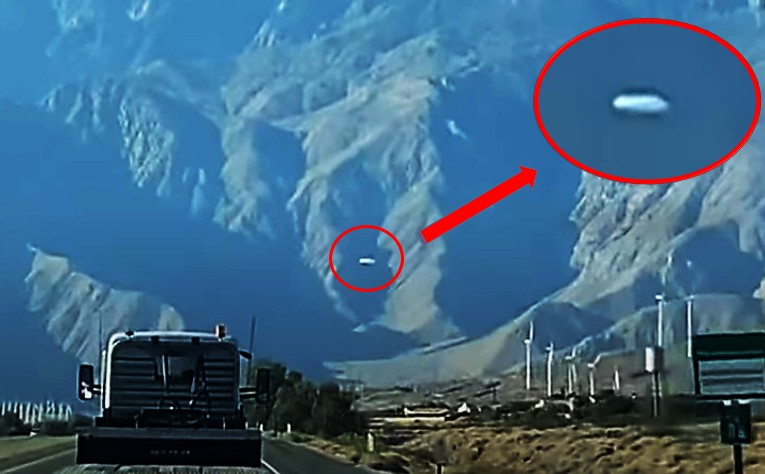Deep beneath the sun-baked hills of Cumae, just a stone’s throw from the bustling streets of Naples, lies a forgotten gateway that whispers secrets from the dawn of civilization. it’s a riddle etched in stone, a trapezoidal tunnel that defies easy explanation and links cultures separated by vast oceans and millennia. The Cave of the Cumaean Sibyl, immortalized in Virgil’s epic Aeneid, is an architectural anomaly that appears scribed in sacred sites worldwide, from the jungles of Mexico to the islands of Malta. Could this be evidence of a shared ancient code, or something even more profound, a universal blueprint embedded in the human psyche?
What draws adventurers, historians, and mystery seekers to this site is its eerie resonance with global enigmas. Discovered in 1932 by archaeologist Amedeo Maiuri, the cave’s perfectly straight 131-meter corridor, carved with a trapezoidal cross-section, leads to a chamber shrouded in shadows. It’s a place where prophecy met peril, where the veil between worlds thinned. This shape isn’t unique to Cumae but pops up in tombs, temples, and portals across the planet, sparking debates about diffusionism, collective unconscious, and even extraterrestrial influences.
The Timeless Legend of the Cumaean Sibyl: Prophetess, Curse, and Eternal Echo
At the heart of Cumae’s mystery stands the Sibyl herself, a figure who blurs the line between myth and historical fact. She’s no ordinary oracle; she’s a tragic icon whose story has captivated poets, philosophers, and rulers for centuries.
Apollo’s Bitter Gift: The Curse of Immortality Without Youth
Imagine a young priestess, radiant and ambitious, catching the eye of the god Apollo. In exchange for her love, she demands a lifespan equal to the grains of sand in her hand—thousands of years. Apollo grants it, but when she spurns him, he twists the boon into a nightmare: eternal life without eternal youth. The Cumaean Sibyl withers into a desiccated husk, her body shrinking until she’s said to have been confined to a jar, her voice a faint rasp echoing prophecies that no one could ignore.
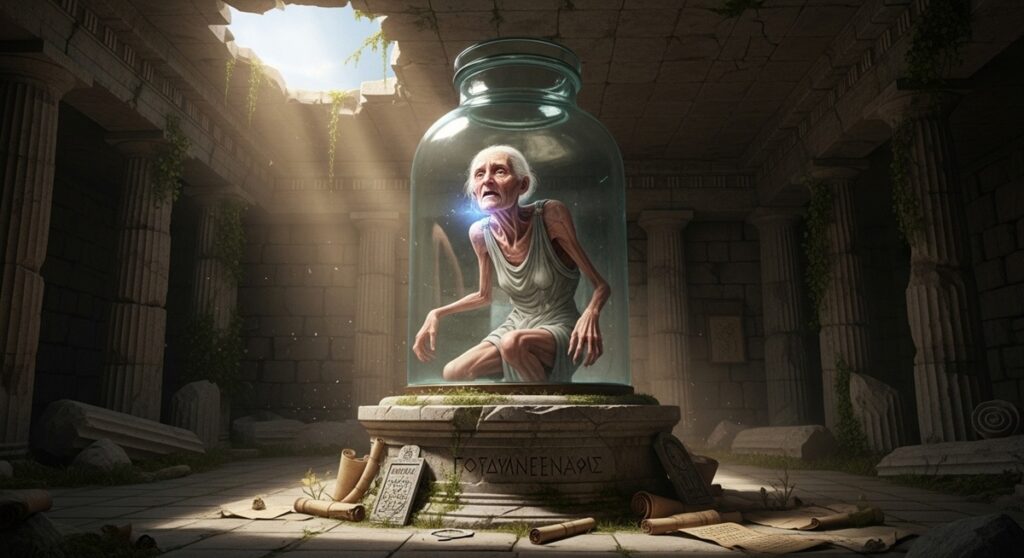
This tale, drawn from ancient sources like Ovid’s Metamorphoses, embodies humanity’s deepest fears: the hubris of seeking forbidden knowledge and the isolation that comes with it. Virgil paints her as Aeneas’s guide to the underworld, her words carrying the weight of divine truth. Yet, her curse underscores a universal theme, the price of foresight. In a world where oracles were consulted for everything from wars to weddings, the Sibyl’s immortality made her prophecies timeless, but her frailty rendered her a prisoner of her own gift. Scholars today see parallels in modern concepts like the “curse of knowledge,” where knowing too much alienates one from society. It’s a reminder that some powers come at an unbearable cost.
The Sibylline Books: A Bargain That Shaped an Empire’s Destiny
No discussion of the Sibyl is complete without the legendary Sibylline Books, a collection of prophecies that became Rome’s most guarded treasure. According to lore, the Sibyl approached King Tarquinius Superbus, the last king of Rome, offering nine scrolls of divine wisdom for a king’s ransom. When he refused, she burned three and offered the remaining six at the same price. He balked again; she torched another trio, leaving three books—and demanded the original sum.
Tarquinius caved, and those books became Rome’s emergency playbook, consulted during plagues, invasions, and omens. Housed in the Temple of Jupiter on the Capitoline Hill, they influenced decisions from the Punic Wars to the empire’s religious reforms. But here’s the intrigue: by destroying two-thirds, the Sibyl didn’t just inflate value through scarcity, she curated history. What alternate futures did those lost pages hold? Were they warnings of paths not taken, or secrets too dangerous to reveal?
Historians like Livy and Dionysius of Halicarnassus recount this episode as a masterclass in negotiation and power. The books survived until 83 BC, when fire claimed them, only to be recompiled from scattered oracles. Their legacy? A testament to how fragmented knowledge can wield more influence than the whole truth, echoing in today’s world of redacted documents and classified intel.
Unveiling the Cave: An Architectural Puzzle from Antiquity
Shifting from myth to mortar, the Cave of the Cumaean Sibyl is a marvel of engineering that begs questions about its creators and purpose.
Discovery and the Tunnel’s Intricate Design
Unearthed in 1932 during excavations at the Cumae Archaeological Park, this man-made grotto stunned experts. Carved into volcanic tuff, the tunnel stretches 131.5 meters, standing 5 meters high and 2.4 meters wide at its base, narrowing trapezoidally upward. Six lateral openings pierce the walls, flooding the passage with ethereal light that shifts with the sun’s arc.
Likely built in the 5th century BC during Cumae’s Greek era, though some argue Etruscan influences, it served multiple roles over time, from oracle’s lair to defensive structure and even Christian burial site. Amedeo Maiuri’s dig aligned it perfectly with Virgil’s descriptions, confirming its identity. Walking it today feels like stepping into a time warp: the smooth walls, the echoing footsteps, the sense of narrowing toward revelation.
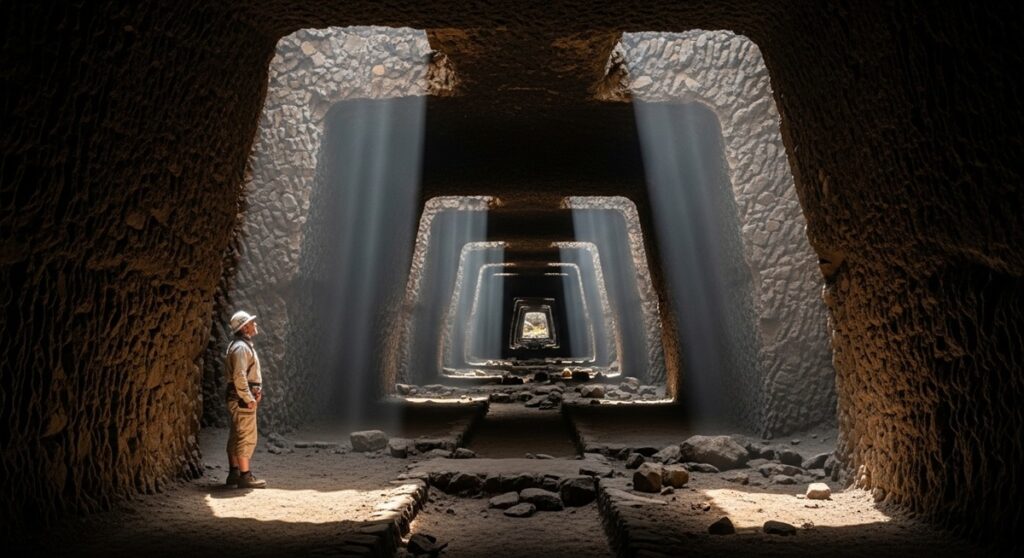
But why trapezoidal? This shape, anti-seismic and structurally sound, prevented collapses in earthquake-prone Campania. Yet, its precision which was achieved without modern tools, hints at advanced knowledge, perhaps passed down from earlier civilizations.
The Chamber of Secrets: Niches and Hidden Meanings
At the tunnel’s end lies a rectangular hall with three enigmatic niches, possibly altars or resting spots for the Sibyl. These could represent triadic deities—Apollo, Hecate, and Demeter—or cosmic realms: underworld, earth, and heavens. The chamber’s acoustics amplify whispers into booms, turning ordinary speech into divine thunder. Modern visitors report chills, as if the Sibyl’s voice lingers.
Echoes Across the Globe: Trapezoidal Portals in Distant Lands
The real bombshell? Cumae’s trapezoid isn’t isolated. This form recurs in sacred architecture worldwide, suggesting connections that mainstream history struggles to explain.
Pacal’s Tomb: A Mayan Mirror in Palenque
In Mexico’s Chiapas jungle, the Temple of the Inscriptions houses King Pacal’s sarcophagus, accessed via a descending trapezoidal passage. Dating to the 7th century AD, it mirrors Cumae’s design, a narrowing path to the afterlife. Pacal, depicted on his lid as ascending or descending realms, aligns with the Sibyl’s role as underworld guide. Coincidence? Or evidence of transatlantic knowledge exchange?
Malta’s Megalithic Marvels: Underground Echoes
The Hypogeum of Ħal Saflieni and Ħaġar Qim temples, built around 3600 BC, feature trapezoidal entrances and chambers. These Neolithic sites, older than Stonehenge, were used for rituals and burials. The shape’s acoustic resonance, similar to Cumae, might have enhanced oracle voices or shamanic chants. Malta’s isolation amplifies the mystery, how did islanders replicate a form seen continents away?
Egyptian, Mesopotamian, and Beyond: A Universal Symbol
Ancient Egypt’s mastabas and pyramid entrances often taper trapezoidally, symbolizing the soul’s ascent. In Mesopotamia, ziggurats’ stepped forms evoke similar transitions. Even Inca architecture at Machu Picchu uses trapezoidal doors for seismic resistance, while Poland’s 5,500-year-old “Kuyavian Mounds”—trapezoidal tombs predating Egypt’s pyramids—add Neolithic layers. India’s Harappan wells with trapezoidal bricks and Mesoamerican stepped pyramids further the pattern. Is this diffusion from a lost mother culture, or innate human design?
Decoding the Purpose: Hypotheses That Bridge Science and Spirit
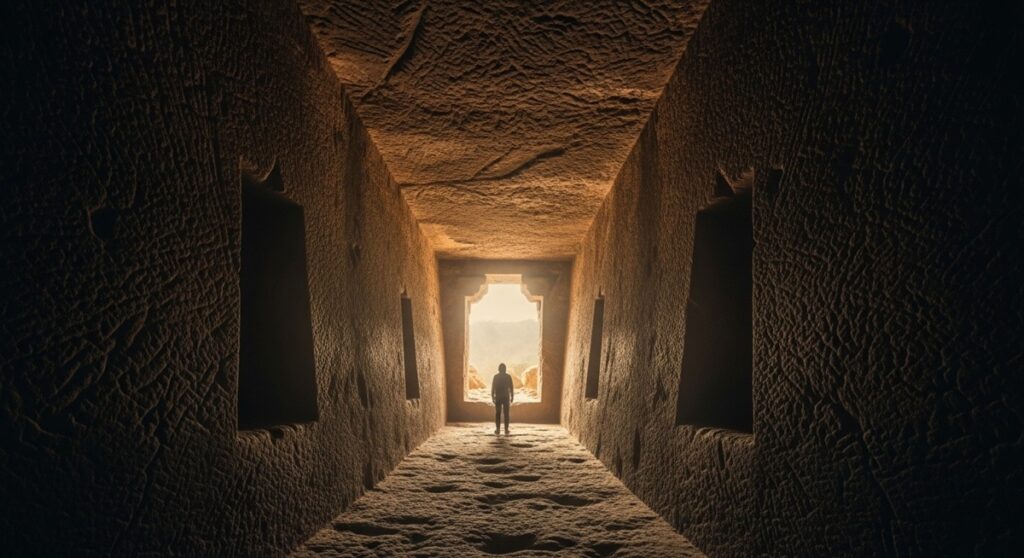
Why this shape, repeated across eras? Theories abound, blending physics, psychology, and mysticism.
Sacred Geometry: Pathways to the Divine
Trapezoids symbolize narrowing journeys—from profane to sacred, life to death. In Cumae, it visually constricts, heightening initiation rites. The three niches evoke trinities, like Christianity’s later adoption.
Acoustic Wizardry: Echoes of the Gods
Studies, like those in the Journal of the Acoustical Society of America, reveal the cave’s reverberation distorts voices, creating “otherworldly” effects. A priestess’s murmur becomes a godly roar, instilling awe. Similar in Malta’s Hypogeum, where low frequencies induce trances.
Astronomical Alignments: Celestial Clues
The tunnel’s axis might track solstices, with light piercing to the chamber during key events. Though unconfirmed, parallels with Newgrange’s winter solstice beam suggest cosmic orientation.
Jungian Archetypes: The Collective Unconscious at Work
Carl Jung’s idea of innate symbols fits: the trapezoid as an archetype of transformation, manifesting independently. It explains global similarities without migration theories, rooting in shared human psychology.
The Shadowy Realm: Lake Avernus and the Gateway to Hades
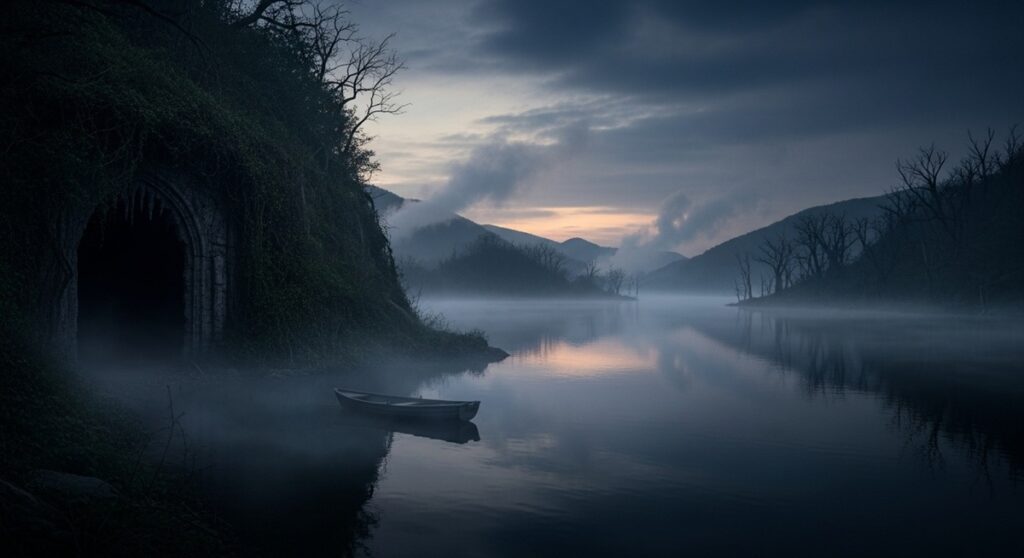
Cumae’s cave ties to Lake Avernus, a volcanic crater nearby. Ancient Romans saw it as Hades’ entrance, its CO2 fumes killing birds mid-flight, hence “Avernus” meaning “birdless.” Virgil’s Aeneas descends here with the Sibyl, blurring myth and geography. The area’s deathly aura amplified her prophecies, making Cumae a liminal zone where mortals brushed eternity.
Modern Mysteries: Implications for Forbidden Archaeology
Today, the cave challenges diffusionist theories, hinting at lost technologies or global networks. Drones and acoustics mapping reveal more, but questions persist. Is it a sanctuary, instrument, or portal? As forbidden archaeology gains traction, sites like this urge rethinking history, not as isolated silos, but interconnected webs.
In the end, the Trapezoidal Portal is a mirror to our quest for meaning. It talks through time, inviting us to question, explore, and wonder. What other codes hide in plain sight?


